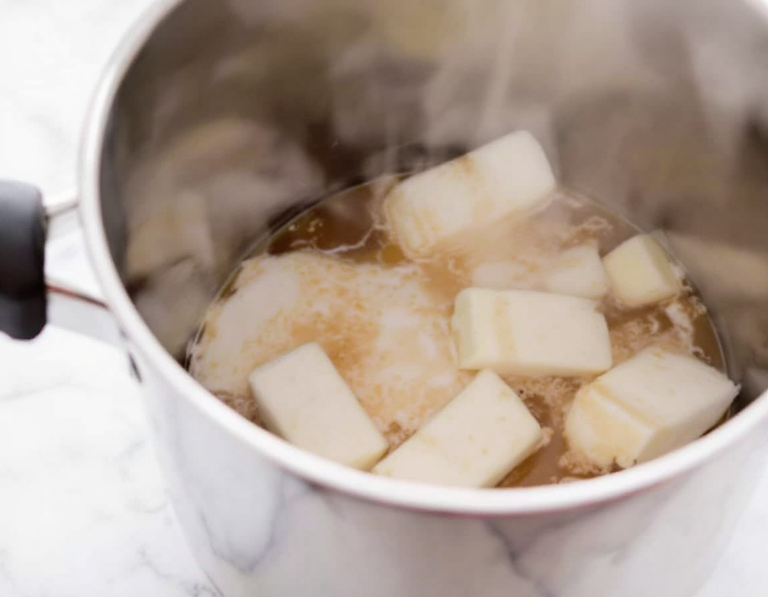
Ah, the allure of the wild American persimmon! These little autumn gems—often overlooked in favor of more mainstream fruits—have a knack for transforming desserts into something quite extraordinary.
Picture this: a crisp fall day, the air tinged with the scent of fallen leaves, and the sweet, almost caramel-like taste of persimmon desserts bringing warmth to your senses.
It’s like nature’s candy, isn’t it?
Steps
- Combine sugar, milk, and butter in a saucepan and bring to a boil. Heat the mixture until it reaches 236°F, the soft ball stage.
- Add the persimmon pulp and continue cooking until the temperature returns to 240°F.
- Remove from heat and mix in vanilla, salt, and cinnamon. Stir until the mixture has cooled slightly and is just warm.
- Pour the candy mixture onto plastic wrap and shape it into a log, or press it into silicone candy molds.
- Chill the candy in the refrigerator for 30 minutes. Slice the log into pieces or remove the candy from the molds for serving.

Ingredients
- 2 cups of sugar
- 1 cup of milk
- 1 tablespoon of unsalted butter
- ½ cup of persimmon pulp
- ¼ teaspoon of kosher salt
- ½ teaspoon of cinnamon
- 2 teaspoons of vanilla
Nutritional Values
Total Nutritional Values for the Entire Recipe | Calories: 425 kcal | Fat: 25g | Saturated Fat: 15g | Cholesterol: 50mg | Sodium: 800mg | Potassium: 700mg | Carbohydrates: 200g | Fiber: 25g | Sugar: 200g | Protein: 25g | Vitamin A: 750IU | Vitamin C: 75mg | Calcium: 300mg | Iron: 25mg |
FAQ
- What type of persimmons are best for making persimmon candy?
- Wild American persimmons, particularly those found in the Midwest, are ideal for this recipe. It’s important to use overripe and super soft persimmons for the best results.
- How can I tell when my candy has reached the soft ball stage without a thermometer?
- To check if the candy has reached the soft ball stage without a thermometer, drop a small piece of the syrup into cold water. If it forms a soft ball when touched, it has reached the correct temperature.
- Can I use Japanese persimmons for this recipe?
- No, this recipe specifically requires wild American persimmons. Japanese varieties typically found in grocery stores are not suitable for making persimmon candy.
- Is there a way to add variety to the persimmon candy recipe?
- Yes, you can add a cup of chopped toasted pecans or walnuts at the end of the cooking process before placing the mixture into candy molds for added texture and flavor.
- What is the best method to extract persimmon pulp from the fruit?
- The most effective way is to gently wash the fruit, remove the tops and stems, pry them open with your fingers, and remove the seeds. Use the remaining pulp and skin for the recipe.
Tips
- Select the Right Persimmons: Use only overly ripe, super soft wild American persimmons for this recipe, as the Japanese varieties will not work well. It’s best to pick them after the first frost when they are just hanging onto their branches or have freshly fallen to the ground.
- Efficient Pulp Extraction: To maximize the pulp yield, gently wash the fruit, remove the top leaves and stem, then pry the fruit open with your fingers to remove the seeds. Utilize the remaining pulp and skin.
- Achieve the Right Candy Stage Without a Thermometer: If you lack a candy thermometer, test the syrup’s readiness by dropping a small piece into cold water. If it forms a soft ball when touched, you have reached the soft ball stage.
- Enhance with Nuts: For a variation, stir in a cup of chopped toasted pecans or walnuts at the end of the cooking process before pouring the mixture into molds. This adds a delightful crunch to the chewy candy.
Equipment
- Candy Thermometer – Essential for measuring the exact temperature of the candy syrup to ensure it reaches the correct stage.
- Silicone Candy Molds – Useful for shaping the candy into individual pieces.
- Fine Sieve or Food Mill – Helpful for extracting pulp from persimmons, though the recipe suggests a simpler method, these tools can still be beneficial for more efficient pulp extraction.
